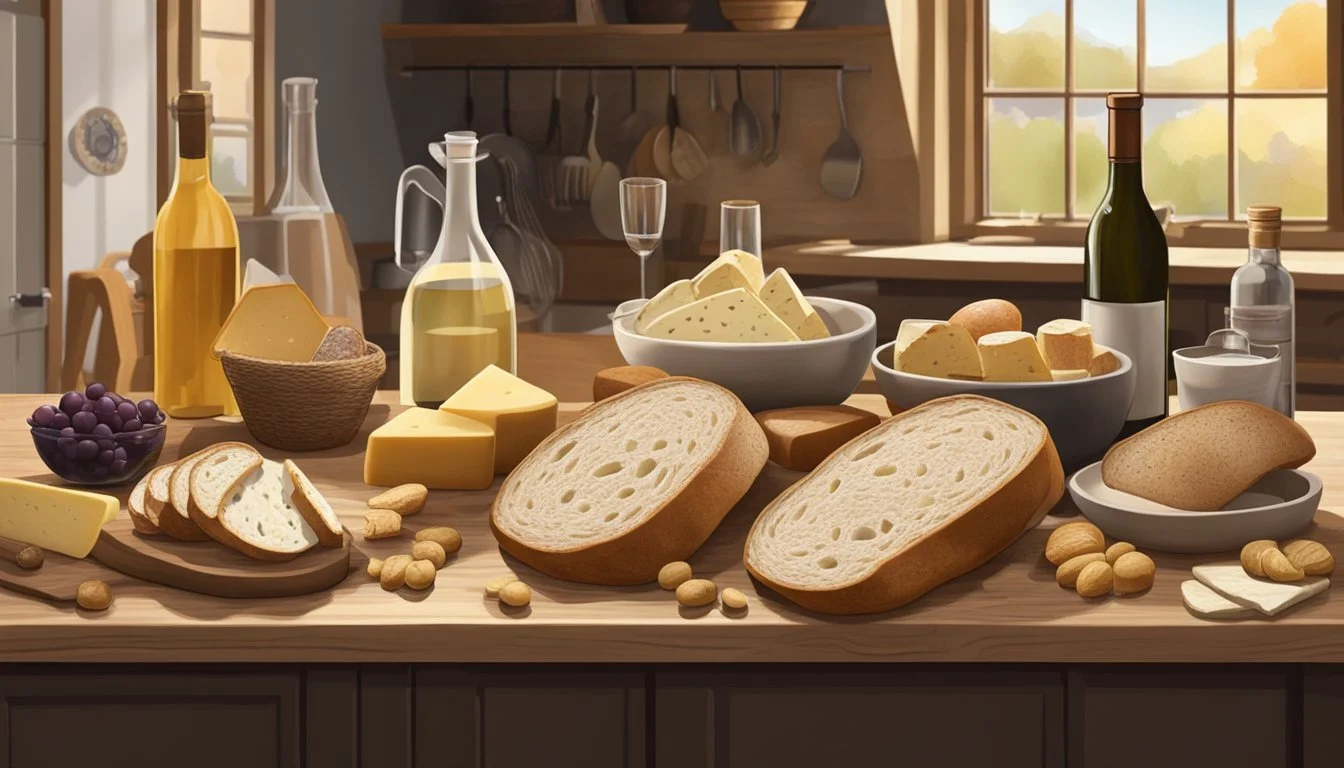Sourdough Bread Pairings
Cheese, Wine, and More - Perfect Matches for Your Loaf
Sourdough bread (What wine goes well with bread?), with its distinct tangy flavor and chewy texture, serves as an excellent base for sophisticated culinary pairings. Its unique taste comes from the natural fermentation process that also leads to the presence of beneficial bacteria, making it a preferred choice for many health-conscious individuals as well as gourmets. Sourdough’s versatility allows it to be paired with a wide range of cheeses (how long does cheese last?) and wines, enhancing the flavors and creating a harmonious dining experience.
The art of pairing sourdough bread involves considering the intensity of the bread's flavor alongside the characteristics of the cheese and wine. Lighter sourdough varieties often complement soft, fresh cheeses (What wine goes well with fresh cheeses?) and delicate white wines, while robust, artisanal sourdoughs can stand up to aged, hard cheeses and full-bodied red wines. This balance between the bread, cheese, and wine elevates the overall taste and can transform a simple meal into an extraordinary one.
For an ideal pairing, one must also take into account the occasion and the desired presentation. Whether it's a casual gathering or a formal dinner party, the choice of sourdough bread should harmonize with the accompanying wine and cheese, both in flavor and aesthetic. The robust tanginess of sourdough pairs exceptionally well with the fruity notes of a Pinot Noir or the bold, full-bodied profile of a Cabernet Sauvignon, while different cheese varieties such as marinated feta or a smooth Comte provide a textural contrast and a myriad of flavor experiences.
The Art of Pairing Sourdough Bread
(What wine goes well with cured meats?)Sourdough bread offers a complex taste profile and versatility in pairings, with each combination magnifying its distinctive sour flavor and chewy texture.
Understanding Sourdough Bread Texture and Flavor
Sourdough bread is known for its characteristic tangy flavor and chewy texture. Its unique qualities are the product of a long fermentation process driven by natural yeast and lactobacillus bacteria present in the sourdough starter. The interaction between the starter, flour, and water not only develops the complex flavors but also gives the bread its distinctively airy crumb and crispy crust.
The Basics of Cheese and Sourdough Bread Pairings
Cheese Type Texture Flavor Suggested Sourdough Camembert Soft, Creamy Rich, Earthy Lighter Sourdough Swiss Semi-hard Mild, Nutty Dense, Chewy Sourdough Parmesan Hard, Aged Rich, Nutty Any Sourdough
Camembert: A soft, creamy cheese like Camembert pairs well with a lighter sourdough. Its rich and earthy flavor complements sourdough's tanginess without overpowering it.
Swiss: Swiss cheese, with its mild and nutty flavor, suits a denser, chewier sourdough loaf, contrasting the bread's acidity with its distinctive taste.
Parmesan: Grated Parmesan can enhance the flavors of any sourdough bread, adding a savory and salty dimension that pairs brilliantly with sourdough's fermented undertones.
Selecting Wines to Complement Sourdough
When one is selecting wines to accompany sourdough bread, it's beneficial to consider the body of the wine and how it will interact with the sourness and texture of the bread.
Full-bodied red wines: Varieties like Cabernet Sauvignon or Malbec are excellent with sourdough, especially when served with tangy cheeses and cured meats (What wine goes well with cured meats?).
Medium-bodied red wines: A wholegrain sourdough loaf goes hand in hand with Merlot or Zinfandel, as they complement the nutty flavors of sourdough and its hearty texture.
By understanding the nuances of sourdough's flavor and texture and carefully choosing complementary cheeses and wines, one can create delightful and sophisticated culinary experiences.
Cheese Pairings for Sourdough
The tanginess of sourdough bread pairs beautifully with a wide range of cheeses. Whether the cheese is soft and creamy or hard and aged, there is a perfect match for every palate. Selecting the right cheese to complement the complex flavors of sourdough can elevate a simple meal to a gourmet experience.
Soft Cheeses with Sourdough
Soft cheeses (What wine goes well with soft cheeses?) like Brie and Camembert offer a buttery richness that contrasts well with the slight acidity of sourdough. When combined, they deliver a meltingly tender bite that's hard to resist.
Brie: A soft cheese with a delicate, earthy flavor.
Camembert: Similar to Brie but with a slightly more intense taste.
Semi-Soft and Creamy Cheeses
Semi-soft cheeses like Havarti and Fontina melt beautifully on warm sourdough, creating a creamy and indulgent treat. These cheeses have a mild, versatile flavor profile that complements the bread's rustic notes.
Havarti: Creamy with a hint of tanginess.
Fontina: Mild and somewhat nutty, perfect for melting.
Hard and Aged Cheeses
Hard cheeses such as Aged Cheddar and nutty Gruyere bring a robust depth of flavor to sourdough. Their complex notes are a good match for the bread's own rich character.
Aged Cheddar: Offers sharpness that cuts through sourdough's tang.
Gruyere: Features a sweet but slightly salty profile that enhances the bread.
Blue and Flavorful Cheeses
Intense blue cheeses (What wine goes well with blue cheeses?) like Roquefort or Gorgonzola accentuate the bold nature of sourdough, providing a pungent counterpoint that food enthusiasts often appreciate for its complexity.
Roquefort: A bold blue cheese with a balance of salty and tangy flavors.
Gorgonzola: Creamy with a sharp and slightly spicy profile.
Best Cheese for Sourdough Bread
The best cheese for sourdough bread may vary depending on one's taste preference, but cheeses like Swiss, Manchego, and Provolone are reliable choices that satisfy a range of flavor profiles.
Swiss: Known for its mild, nutty flavor that pairs well with sourdough.
Manchego: A Spanish cheese with a firm texture and fruity undertones.
Provolone: Offers a smooth taste with a subtle sharpness.
Sourdough Bread and Wine Synergy
The interaction between sourdough bread and wine enhances the flavors in both, with certain types of wines pairing exceptionally well with the unique tanginess of sourdough.
Pairing Red Wines with Sourdough
Pinot Noir: This lighter red wine, with its earthy and fruity notes, is a perfect companion for sourdough's mild tang. A glass of Pinot Noir and a slice of sourdough can create a cozy and inviting flavor experience.
Cabernet Sauvignon: For a more robust combination, the boldness of a full-bodied Cabernet Sauvignon complements the hearty and rustic qualities of sourdough, satisfying the palate of those preferring intense flavors.
Chianti: Sourdough also pairs nicely with a Chianti, which can harmonize with the bread's sour notes while its tannins align with the textural components of the crust.
Pairing White Wines with Sourdough
Sauvignon Blanc: The acidity in a crisp, dry Sauvignon Blanc works well to cut through the richness of sourdough, offering a refreshing counterbalance to each bite.
Chardonnay: A glass of Chardonnay, either oaked or unoaked depending on personal preference, complements sourdough with its versatility and complexity, making it a safe and enjoyable choice for various sourdough types.
Wine Selection by Sourdough Type
Classic Sourdough: Opt for a vintage wine that can match the traditional flavors of sourdough. A well-aged wine may have developed subtleties that echo the complexities of sourdough's taste profile.
Herbed Sourdough Variants: When selecting wines to pair with herbed sourdough, consider the specific herbs used and choose a wine that best complements those flavors.
In any pairing, individual taste preference is paramount; these are starting points to explore the synergy between sourdough bread and wine.
Accompaniments and Toppings
Sourdough bread offers a perfect canvas for a variety of flavors and textures, with toppings ranging from nuts and seeds that add a crunchy contrast to spreads that marry sweet and savory notes, and fresh fruits that provide a burst of natural sweetness.
Nuts and Seeds that Enhance Sourdough
Nuts: A sprinkle of nuts, such as sliced almonds or chopped walnuts, introduces a delightful crunch and nutty flavor to sourdough. They are often paired with cheeses for a rich and satisfying experience.
Seeds: For a healthful twist, seeds like sunflower or pumpkin seeds can be added for their subtle crunch and nutritional benefits. They complement both sweet and savory toppings.
Table 1: Nuts & Seeds Pairing Suggestions
Nut/Seed Type Suggested Pairing Notes Almonds Sliced and toasted Brings out a deep, nutty flavor Walnuts Chopped Offers a sharp contrast in texture Sesame Seeds Lightly toasted Adds a subtle crunch
Sweet and Savory Spreads
Butter: A classic choice, good quality butter brings richness that softens the tang of sourdough, making it a staple for many.
Honey: Drizzling honey onto sourdough with a layer of butter or rich, savory cheese offsets its sharpness with its natural sweetness.
Almond Butter: An alternative to peanut butter, almond butter lends a creamy texture and nutty, slightly sweet flavor.
Fresh Fruits and Sourdough Combinations
Sliced Apples: Thinly sliced apples layered on sourdough create a crisp, juicy addition that contrasts well with both sharp cheeses and sweet spreads.
Fresh Fruits: Seasonal fruits like figs or berries can elevate a simple slice of sourdough, especially when paired with a soft cheese like goat cheese or burrata.
Specific Sourdough Types and Their Pairings
In the realm of sourdough bread, each variant carries distinct flavors that are complemented by select pairings. This section guides readers through optimal combinations for three specific sourdough types, enhancing their culinary experience.
Baguette and French Classics
The classic French baguette, known for its crispy crust and soft, airy interior, pairs exceptionally with traditional French cheeses. A staple is Brie or Camembert, whose creamy textures meld seamlessly with the baguette's crunch. When it comes to wine, a light-bodied Pinot Noir complements the delicate wheat flavors without overpowering them.
Cheese: Brie, Camembert
Wine: Pinot Noir
Focaccia and Italian Inspirations
Focaccia, an Italian oil-rich bread with a firm yet chewy texture, is often studded with herbs and toppings. It shines alongside a platter of olives and sun-dried tomatoes, embodying the essence of Italian cuisine. For cheese, a slice of Mozzarella or Provolone offers a subtle, milky contrast. Pairing it with a Chianti or Sangiovese wine accentuates the herbaceous notes.
Accompaniments: Olives, sun-dried tomatoes
Cheese: Mozzarella, Provolone
Wine: Chianti, Sangiovese
Rye Bread and Robust Choices
Rye sourdough bread possesses a distinctive dense crumb and a range from light, subtle flavors to dark, rich tones. The intensity of aged Cheddar or a slice of Gruyère holds up against the robust nature of rye. To elevate the experience, one might choose a full-bodied Merlot or a Rye Whiskey that echoes the bread's own deep flavors.
Cheese: Aged Cheddar, Gruyère
Beverage: Merlot, Rye Whiskey
Meal Ideas with Sourdough Bread
Sourdough bread, with its tangy flavor and chewy texture, complements a variety of meals. From breakfast to dinner, sourdough is a versatile choice for crafting flavorful dishes.
Breakfast Options
For an energizing start, sourdough makes an excellent foundation for avocado toast, with creamy slices of avocado, a sprinkle of red pepper flakes, and a dash of sea salt. Alternatively, sourdough French toast offers a heartier morning meal, especially when topped with fresh berries and a drizzle of maple syrup.
Sourdough Sandwich Innovations
Sandwich enthusiasts can elevate their lunch game with sourdough grilled cheese sandwiches. Sourdough bread's robust structure holds up well to an array of cheeses melted to gooey perfection. Creative fillings like caramelized onions or apple slices add another level of taste and texture.
Classic Combo: A grilled cheese sandwich paired with steaming tomato soup - this pairing never goes out of style.
Avant-Garde Option: For a twist, they can try a sourdough sandwich with balsamic onion, arugula, and goat cheese.
Soup and Sourdough: A Hearty Duo
Sourdough bread serves as the perfect companion to a bowl of soup. It absorbs the rich flavors without falling apart, whether it's dunked into a classic tomato soup or used to scoop up a chunkier meat stew. Serving warm sourdough on the side of one's favorite soup turns any meal into comfort food.
Sourdough Salads and Side Dishes
In salads and sides, sourdough bread acts as a hearty addition to lighter fare. Caprese salad (What wine goes well with caprese salad?) gains a new dimension with chunks of toasted sourdough mingling with fresh tomatoes, mozzarella, and basil. Similarly, a panzanella salad showcases sourdough’s ability to soak up vinaigrettes while maintaining a satisfying texture.
Savory Croutons: Sourdough croutons, crisped in the oven and seasoned with garlic and herbs.
Elegant Pairing: A side of sourdough with a balsamic-drizzled caprese salad for a sophisticated touch.
Health and Nutritional Aspects
When considering health and nutrition, sourdough bread is notable for its fermentation process, which may affect its caloric content and influence the protein and fat composition beneficially.
Caloric and Carbohydrate Content
Sourdough bread typically contains a similar caloric value to other breads, with a single slice averaging around 80 to 120 calories depending on its size and ingredients. Carbohydrate content can fluctuate but generally hovers around 15 to 20 grams per slice. However, due to the presence of lactic acid bacteria, the glycemic index is often lower compared to bread made with baker's yeast.
Calories: 80-120 per slice
Carbohydrates: 15-20g per slice
Glycemic Index: Lower due to fermentation
Proteins and Fats in Sourdough
In sourdough bread, protein levels are typically around 2 to 4 grams per slice, while total fat remains low, commonly around 1 gram per slice. Sourdough does not contain significant amounts of saturated fat, and it has minimal sugar content, often less than a gram per slice. The fermentation process may also increase the bioavailability of nutrients making protein and minerals more accessible for absorption.
Protein: 2-4g per slice
Total Fat: 1g per slice
Saturated Fat: Minimal
Sugar: <1g per slice
Baking Your Own Sourdough Bread
Baking sourdough bread at home allows one to explore a vast array of flavors and textures, providing an opportunity to create a truly personal and artisanal experience.
Creating Your Sourdough Starter
A sourdough starter is a mixture of flour and water that captures wild yeasts and beneficial bacteria from the environment. It's the heart of sourdough breadmaking.
Steps to create a sourdough starter:
Mix equal parts flour and water in a jar (start with 1/2 cup of each).
Cover the jar loosely and let it sit at room temperature.
Feed the starter daily with equal parts flour and water.
After 5-7 days, the starter should be bubbly and have a tangy aroma indicating it's ready to use. A mature starter imparts the signature sour flavor and is rich in lactic and acetic acids which contribute to the bread's taste.
Bread Shapes and Types
Different types of breads can be crafted from sourdough starter, with each bringing its unique texture and flavor profile.
Popular sourdough bread types and their shapes:
Ciabatta: An Italian bread known for its elongated, slipper-like shape and chewy texture.
Walnut Bread: Often a boule (round loaf) with walnut pieces incorporated, providing a rich, nutty taste.
Spelt Sourdough: Made with spelt flour, typically formed into a round or oblong loaf and known for its slightly sweet and nutty flavor.
Experimentation with shapes, such as a batard or a classic round boule, can influence both the bread's crust and its crumb structure.
The Role of Bakers and Commercial Yeast
Bakers have traditionally relied on the wild yeasts present in a sourdough starter to leaven bread, as opposed to commercial yeast.
Comparison of sourdough starters and commercial yeast:
Sourdough Starters: Contain wild yeasts and bacteria which create a complex, tangy flavor and can take longer to rise.
Commercial Yeast: Quicker leavening agent that produces a more neutral flavor and consistent results.
While commercial yeast offers predictability and convenience, sourdough starters give bakers the chance to cultivate a distinctive taste and texture that cannot be replicated with commercial yeast. Additionally, the slow fermentation process of sourdough starters can break down gluten, making it more digestible for some people.
Frequently Asked Questions
What are the best cheese pairings for sourdough bread?
Sourdough bread pairs exceptionally well with a variety of cheeses. For a balanced taste, one might consider these options:
Brie: With its creamy texture, it complements the tangy profile of sourdough.
Cheddar: A sharp cheddar offers a nice contrast to sourdough's sourness.
Gouda: Its sweet and buttery flavor harmonizes with the rustic notes of sourdough.
Blue cheese: The bold flavors of blue cheese match the complexity of sourdough.
Is there a type of wine that goes well with sourdough bread?
When pairing sourdough with wine, aim for harmony between the flavors:
White wines with high acidity, like Sauvignon Blanc, can enhance the sourdough's tang.
Full-bodied red wines, such as Cabernet Sauvignon, often pair well with heartier sourdough loaves.
What are some non-cheese accompaniments for sourdough bread?
Beyond cheese, one can serve sourdough with:
Olive tapenade or pesto for a flavorful spread.
Quality butter to highlight sourdough's texture.
Smoked salmon or prosciutto for a savory protein complement.
Can sourdough bread be used for sweet pairings?
Yes, sourdough can be quite versatile:
Try it toasted with a spread of nut butter and a drizzle of honey.
Complement it with jam or fruit preserves for a simple yet satisfying treat.
By experimenting with these combinations, one will find the perfect pairings to suit their palate while serving sourdough bread.





